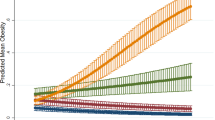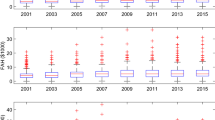Abstract
Older people (i.e., at least 50 years of age) are becoming one of the most important demographic groups in the world. We explore the effect of food away from home expenditures on obesity among the older population in Europe using instrumental variable methods. Several statistical tests were conducted to assess endogeneity of selected variables, the exogeneity, relevance, and validity of instruments used. Our results generally suggest that food-away-from-home expenditure has no statistically significant effect on body mass index (BMI) of older males but is negatively related to BMI of older females.
Similar content being viewed by others
References
Anderson M, Matsa DA (2009) Are restaurants really supersizing America?. UC Berkeley and Northwestern University, Mimeo
Anderson PM, Butcher KF, Levine PB (2004) Maternal employment and childhood obesity. In: Philipson T, Dai C, Helmchen L, Variyam JN (eds) The economics of obesity: A Report on the Workshop Held at USDA’s Economic Research Service. Economic Research Service/USDA, pp 14–17
Angrist JD, Pischke J-S (2009) Mostly harmless econometrics: an empiricist’s companion. Princeton University Press, Princeton
Bascle G (2008) Controlling for endogeneity with instrumental variables in strategic management research. Strateg Organ 6(3): 285–327. doi:10.1177/1476127008094339
Baum CF, Schaffer ME (2007) Enhanced routines for instrumental variables/generalized method of moments estimation and testing. Stata J 7(4): 465–506
Baum CF, Schaffer ME, Stillman S (2003) Instrumental variables and GMM: estimation and testing. Stata J 3(1): 1–31
Baum CF, Schaffer ME, Stillman S (2007) ivreg2: Stata module for extended instrumental variables/2SLS, GMM and AC/HAC, LIML, and k-clas regression. Boston College Department of Economics, Statistical Software Components S425401 Downloadable from http://ideasrepecorg/c/boc/bocode/s425401.html
Becker GS, Murphy KM (1988) A theory of rational addiction. J Polit Econ 96(4): 675–700
Börsch-Supan A (2005) Introduction. In: Börsch-Supan A, Brugiavini A, Jürges H, Mackenbach J, Siegrist J, Weber G (eds) Health, Ageing and Retirement in Europe—first results from the Survey of Health, Ageing and Retirement in Europe. Mannheim Research Institute for the Economics of Aging, Mannheim
Börsch-Supan A, Jürges H (2005) The Survey of Health, Aging, and Retirement in Europe—methodology. Strauss GmbH, Mannheim Research Institute for the Economics of Aging (MEA), Manheim
Bound J, Jaeger DA, Baker RM (1995) Problems with instrumental variables estimation when the correlation between the instruments and the endogeneous explanatory variable is weak. J Am Stat Assoc 90(430): 443–450. doi:10.2307/2291055
Bray GA (2004) Medical consequences of obesity. J Clin Endocrinol & Metab 89(6): 2583–2589. doi:10.1210/jc.2004-0535
Browning M, Crossley TF, Weber G (2003) Asking consumption questions in general purpose surveys. Econ J 113(491): F540–F567. doi:10.1046/j.0013-0133.2003.00168.x
Cawley J (1999) Rational addiction, the consumption of calories, and body weight. PhD Dissertation, The University of Chicago
Chou S-Y, Grossman M, Saffer H (2004) An economic analysis of adult obesity: results from the behavioral risk factor surveillance system. J Health Econ 23: 565–587. doi:10.1016/j.jhealeco.2003.10.003
Chou S-Y, Rashad I, Grossman M (2008) Fast-food restaurant advertising on television and its influence on childhood obesity. J Law & Econ 51(4): 599–618. doi:10.1086/590132
Christensen H, Mackinnon AJ, Korten A, Jorm AF (2001) The “common cause hypothesis” of cognitive aging: Evidence for not only a common factor but also specific associations of age with vision and grip strength in a cross-sectional analysis. Psychol Aging 16(4): 588–599. doi:10.1037/0882-7974.16.4.588
Currie J, Dellavigna S, Moretti E, Pathania V (2010) The effect of fast food restaurants on obesity and weight gain. Am Econ J Econ Pol 2(3): 32–63. doi:10.1257/pol.2.3.32
Cutler DM, Glaeser EL, Shapiro JM (2003) Why have Americans become more obese?. J Econ Perspect 17(3): 93–118. doi:10.1257/089533003769204371
Dockner EJ, Feichtinger G (1993) Cyclical consumption patterns and rational addiction. Am Econ Rev 83(1): 256–263
Dunn RA (2007) Obesity and the availability of fast-food: an instrumental variables approach. In: International health economics association 6th world congress: explorations in health economics, Compenhagen, Denmark
Dunn RA (2010) The effect of fast-food availability on obesity: an analysis by gender, race, and residential location. Am J Agr Econ 92(4): 1149–1164. doi:10.1093/ajae/aaq041
Ejerblad E, Fored CM, Lindblad P, Fryzek J, McLaughlin JK, Nyren O (2006) Obesity and risk for chronic renal failure. J Am Soc Nephrol 17(6): 1695–1702. doi:10.1681/asn.2005060638
Esposito K, Giugliano F, Di Palo C, Giugliano G, Marfella R, D’Andrea F, D’Armiento M, Giugliano D (2004) Effect of ifestyle changes on erectile dysfunction in obese men: a randomized controlled trial. J Am Med Assoc 291(24): 2978–2984. doi:10.1001/jama.291.24.2978
Ewing R, Schmid T, Killingsworth R, Zlot A, Raudenbush S (2003) Relationship between urban sprawl and physical activity, obesity, and morbidity. Am J Health Promot 18(1): 47–57. doi:10.1007/978-0-387-73412-5_37
Frank TH (2006) A taxonomy of obesity litigation. U Arkansas Little Rock Law Rev 28(3): 427–441
Frederiksen H, Gaist D, Petersen HC, Hjelmborg J, McGue M, Vaupel JW, Christensen K (2002) Hand grip strength: A phenotype suitable for identifying genetic variants affecting mid- and late-life physical functioning. Genet Epidemiol 23(2): 110–122. doi:10.1002/gepi.1127
Goldfarb RS, Leonard TC, Suranovic S (2006) Modeling alternative motives for dieting. Eastern Econ J 32(1): 115–131
Grundy SM (2004) Obesity, metabolic syndrome, and cardiovascular disease. J Clin Endocr & Metab 89(6): 2595–2600. doi:10.1210/jc.2004-0372
Hansen LP (1982) Large sample properties of generalized method of moments estimators. Econometrica 50(4): 1029–1054
Huffman SK, Rizov M (2010) The rise of obesity in transition: theory and empirical evidence from Russia. J Dev Stud 46(3): 574–594. doi:10.1080/00220380903383230
Kim S-Y, Nayga RM Jr, Capps O Jr (2001) Food label use, self-selectivity, and diet quality. J Consum Aff 35(2): 346–363. doi:10.1111/j.1745-6606.2001.tb00118.x
Kleibergen F, Paap R (2006) Generalized reduced rank tests using the singular value decomposition. J Econometrics 133(1): 97–126. doi:10.1016/j.jeconom.2005.02.011
Kyureghian G, Nayga RM Jr, Davis GC, Lin B-H (2007) Food away from home consumption and obesity: An analysis by service type and by meal occasion. Selected paper prepared for presentation at the American Agricultural Economics Association Annual Meeting, July 29–August 1, Portland, Oregon
Lakdawalla DN, Philipson TJ (2002) The growth of obesity and technological change: A theoretical and empirical examination. National Bureau of Economic Research Working Paper No W8946
Lakdawalla DN, Philipson TJ (2006) Economics of obesity. In: Jones AM (eds) The Elgar companion to health economics. Edward Elgar Publishing Limited, Northampton, pp 72–82
Levy A (2002) Rational eating: can it lead to overweighhtness or underweightness?. J Health Econ 21: 887–899. doi:10.1016/S0167-6296(02)00036-X
Levy A (2003) A theory of LTR Junk-food consumption. University of Wollongong, Working paper 03-05
Lewbel A (2010) Using heteroskedasticity to identify and estimate mismeasured and endogenous regressor models. Working paper, Department of Economics, Boston College
Long SK (2008) Do for-profit health plans restrict access to care under medicaid managed care?. Med Care Res Rev 65(5): 638–648. doi:10.1177/1077558708316930
Loureiro ML, Nayga RM Jr (2005) International dimensions of obesity and overweight related problems: an economics perspective. Am J Agr Econ 87(5): 1147–1153. doi:10.1111/j.1467-8276.2005.00800.x
McLean-Meyinsse PE (2001) An analysis of nutritional label use in the Southern United States. J Food Distr Res 32(1): 110–114
Moreira MJ (2003) A conditional likelihood ratio test for structural models. Econometrica 71(4): 1027–1048. doi:10.1111/1468-0262.00438
Murray MP (2006) Avoiding invalid instruments and coping with weak instruments. J Econ Perspect 20(4): 111–132. doi:10.1257/jep.20.4.111
Nayga RM Jr (2008) Nutrition, obesity, and health: policies and economic research challenges. Eur Rev Agr Econ 35(3): 281–302. doi:10.1093/erae/jbn013
Pagan AR, Hall D (1983) Diagnostic tests as residual analysis. Economet Rev 2(2): 159–218
Palkhivala A (2002) Obesity hits elderly harder than younger patients. Special to Doctor’s Guide news. http://www.pslgroupcom/dg/220d4e.htm
Philipson TJ, Posner RA (2003) The long-run growth in obesity as a function of technological change. Perspect Biol Med 46(S3): S87–S107
Plantinga AJ, Bernell S (2007) The association between urban sprawl and obesity: is it a two-way street?. J Reg Sci 47(5): 857–879. doi:10.1111/j.1467-9787.2007.00533.x
Rantanen T, Masaki K, Foley D, Izmirlian G, White L, Guralnik JM (1998) Grip strength changes over 27 yr in Japanese-American men. J Appl Physiol 85(6): 2047–2053
Rantanen T, Guralnik JM, Foley D, Masaki K, Leveille S, Curb JD, White L (1999) Midlife hand grip strength as a predictor of old age disability. JAMA 281(6): 558–560. doi:10.1001/jama.281.6.558
Rashad I, Grossman M, Chou S-Y (2006) The supersize of America: an economic estimation of body mass index and obesity in adults. Eastern Econ J 32: 133–148
Schaffer ME (2002) ivhettest: Stata module to perform Pagan-Hall and related heteroskedasticity tests after IV. Department of Economics, School of Management and Languages, Heriot-Watt University, Edinburgh, Statistical Software Components S428801 Downloadable from http://ideasrepecorg/c/boc/bocode/s428801.html
Shea J (1997) Instrument relevance in multivariate linear models: a simple measure. Rev Econ Stat 79(2): 348–352
Smith PK, Bogin B, Bishai D (2005) Are time preference and body mass index associated?: Evidence from the National Longitudinal Survey of Youth. Econ Hum Biol 3(2): 259–270. doi:10.1016/j.ehb.2005.05.001
Stock JH, Yogo M (2005) Testing for weak instruments in linear IV regression. In: Andrews DWK, Stock JH (eds) Identification and inference for econometric models: essays in honor of Thomas Rothenberg. Cambridge University Press, New York, pp 80–108
Suranovic SM, Goldfarb RS (2006) A behavioral model of cyclical dieting. In: Bolin K, Cawley J (eds) The economics of obesity. Advances in Health Economics and Health Services Research. JAI Press, Amsterdam, pp 49–78
Thompson SB (2011) Simple formulas for standard errors that cluster by both firm and time. J Financ Econ 99(1): 1–10. doi:10.1016/j.jfineco.2010.08.016
van der Steeg JW, Steures P, Eijkemans MJC, Habbema JDF, Hompes PGA, Burggraaff JM, Oosterhuis GJE, Bossuyt PMM, van der Veen F, Mol BWJ (2008) Obesity affects spontaneous pregnancy chances in subfertile, ovulatory women. Hum Reprod 23(2): 324–328. doi:10.1093/humrep/dem371
Wansink B, Huckabee M (2005) De-marketing obesity. Calif Manage Rev 47(4): 6–18
Whitmer RA, Gunderson EP, Barrett-Connor E, Quesenberry CP Jr, Yaffe K (2005) Obesity in middle age and future risk of dementia: a 27 year longitudinal population based study. Brit Med J 330(7504): 1360–1364. doi:10.1136/bmj.38446.466238.E0
WHO (2006) Obesity and Overweight. Fact Sheet No 311. World Health Organization
Yang Z, Hall AG (2008) The financial burden of overweight and obesity among elderly Americans: The dynamics of weight, longevity, and health care cost. Health Serv Res 43(3): 849–868. doi:10.1111/j.1475-6773.2007.00801.x
You W, Davis GC (2010) Household food expenditures, parental time allocation, and childhood overweight: An integrated two-stage collective model with an empirical application and test. Am J Agr Econ 92(3): 859–872. doi:10.1093/ajae/aap031
Zhang L, Rashad I (2008) Obesity and time preference: The health consequences of discounting the future. J Biosoc Sci 40(1): 97–113. doi:10.1017/S0021932007002039
Author information
Authors and Affiliations
Corresponding author
Rights and permissions
About this article
Cite this article
Drichoutis, A.C., Nayga, R.M. & Lazaridis, P. Food away from home expenditures and obesity among older Europeans: are there gender differences?. Empir Econ 42, 1051–1078 (2012). https://doi.org/10.1007/s00181-011-0453-4
Received:
Accepted:
Published:
Issue Date:
DOI: https://doi.org/10.1007/s00181-011-0453-4




